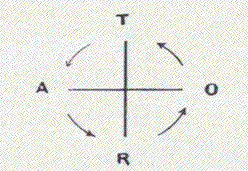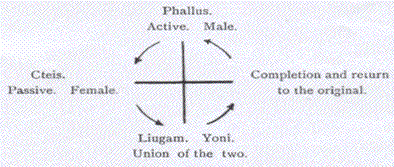obviously has reference to this word.
There is a symbol of great antiquity, the cross enclosed in a circle, which may perhaps have a similar meaning to that the letters of the Tetragrammaton have when extended on a cross or circle; but the symbol has been in existence long before the time of the Mediaeval Mystics, or, indeed, before the Cabbala had been written.
If some of the passages in the Zohar are closely followed and taken in a more literal sense than was perhaps intended by the writers, it will not be difficult to conceive how easily Phallic symbols came to be substituted, for the mystical meanings the Cabbalists connected with the letters of the Tetragrammaton.
It is not pleasant to introduce the Phallic element in reference to the NAME, but it is necessary to do so to understand the meaning of the symbols on the Tarot Cards. [Page 14]
In short, then, the Yod becomes the Phallus; the Hé the Cteis; and Vau, a figure similar to the Indian Lingam Yoni, etc..
The wandering tribes known by the various names of Gypsies, Bohemians, Zingari, have for many centuries been in possession of playing cards bearing very singular symbols.
Instead of having the Clubs, Hearts, Spades, and Diamonds of modern playing cards, these cards have in their place, as they are termed by French authors, the Tarot, the Baton, Coupe, Épée, and Denier. (This last represents, or is the name of, an ancient coin or circle.)
The Baton is also described as a staff, club, or budding rod.
The Coupe....
The Épée is generally represented as a sword piercing a crown.
And the Denier, as a disc with a lotus or lily flower in the centre, a centre or a ring.
These cards have been used by the Bohemian gypsies for centuries for fortune telling, and are called Tarot Cards.
A game is still played with ordinary modern cards in Bohemia called Taroc.
It can hardly be a matter of accident that the symbols or hieroglyphics on these Taro cards should be so closely resemble, as will be seen, the mystical Phallic ideas which the writers of the Zohar dared to connect with the letters of that NAME which they considered it to be blasphemous to utter.
Take, firstly, the Cabbalistic idea of the extended NAME

Secondly, the idea of the mystics, who substituted the letters of Taro or Rota for the Hebrew letters.

[Page 15] Thirdly, substitute for these the Phallic idea derived from the Cabbala.

And fourthly, in place of these, substitute the symbols of the Taro.

It is almost unnecessary to explain that the Baton, Club, Sceptre=the Phallus. Coupe, Cup=the Cteis.
Sword piercing the Crown= Lingam. Yoni Circle=Return of the Divine Nature to itself again in eternal repetition.
The Circle, or Disc, may also represent the double of the Cup; by one Cup being inverted on the other, Generator became Creator.
In modern English cards one of these has perhaps been preserved in the name of Club, and another in that of the Spade.
The double triangle also which forms the Diamond is a well-known sign which, according to mystical authorities, in some degree corresponds to the Circle.
The Heart does not, however, either in form or name, bear any resemblance to the Coupe or Cup of the Tarot.
So far as regards the Cabbalistic origin of th curious signs, an origin which the Count de Gebelin and the more recent French mystics, including the author writes under the name of Eliphas Levi, have attempted to prove. But have they had their origin from this source? It seems more probable that these Tarot hieroglyphics had their origin far to the eastward of the land of the Cabbalists or of the authors of the Zohar. And it is a remarkable thing that, if their origin is from India, they should so closely coincide with the Symbolism, which might be given [Page 16] to the notions of the authors of the Zohar, on the mystical meaning of the letters of the Tetragrammaton. That they are of Indian origin seems more than probable, for does not the Hindû double sexed God and Goddess Arddha-Nari (Isis, Nature) bear in his or her four hands symbols identically the same as those on the Tarot Cards?
The Sceptre or Bâton, the Sword, the Cup, and the Circle or Ring.
The order is not the same, but thus:
Sceptre. Sword
Cup. Ring.
This is no doubt a curious fact, and it goes far also to show that India was the original country of the Gipsy Tribes.
The French writers gave much more importance to these Tarot Symbols than they deserve, and every sensible person will protest against such a profanation of Holy Names, by using authropomorphic emblems such as these.
But the Symbols themselves are curious, and show the similarity of Phallic notions among peoples so far removed from each other by both distance and culture as the Hindûs and the writers of the Zohar.
Every being is at ease when its powers move regularly and without interruption. Now, a rational being is in this prosperous condition when its judgment is gained by nothing but truth and evidence, when its designs are all meant for the advantage of society, when its desires and aversions are confined to objects within its power, when it rests satisfied with the distributions of the universal nature of which it is a part, just as much as a leaf belongs to the nature of the tree that bears it. Only with this difference, that a leaf is part of a nature without sense or reason, and liable to be checked in its operations, whereas is a limb as were of an intelligent, righteous, and irresistible being, that is all wisdom, and assigns matter and form, time, force, and fortune, to everything in one measure and proportion. And this you will easily perceive if you do not compare one thing with another in every details, but compare the whole of one thing with the whole of another.
Meditations - Marcus Aurelius
Go to Top of this page
Back to our On Line Documents
Back to our Main Page
A free sample copy of our bilingual magazine can be sent to you. This
offer is only good for a mailing to a Canadian address. You have to supply a mailing address.
The Canadian membership of $25.00 includes
the receipt of four seasonal issues of our magazine "The Light Bearer" . If you are a resident of
Canada send a note to enquirers@theosophical.ca requesting
a packet of information and your free copy of our magazine
For membership outside of Canada send a message to the International Secretary in Adyar, India theossoc@satyam.net.in
For a problem viewing one of our documents - or to report an error in a document - send a
note to the webmaster at webmaster@theosophical.ca
We will try to answer any other query -if you would send a note to info@theosophical.ca
This document is a publication of the
Canadian Theosophical Association (a regional association of the Theosophical Society in Adyar)
89 Promenade Riverside,
St-Lambert, QC J4R 1A3
Canada
To reach the President - Pierre Laflamme dial 450-672-8577
or Toll Free - from all of Canada 866-277-0074
or you can telephone the national secretary at 905-455-7325
website: http://www.theosophical.ca